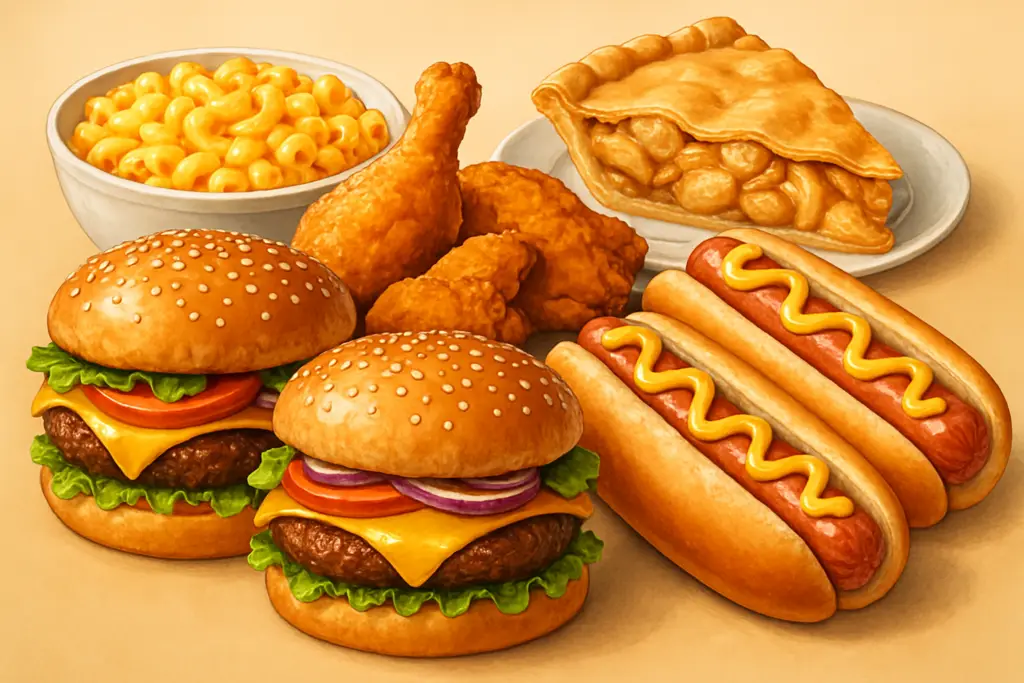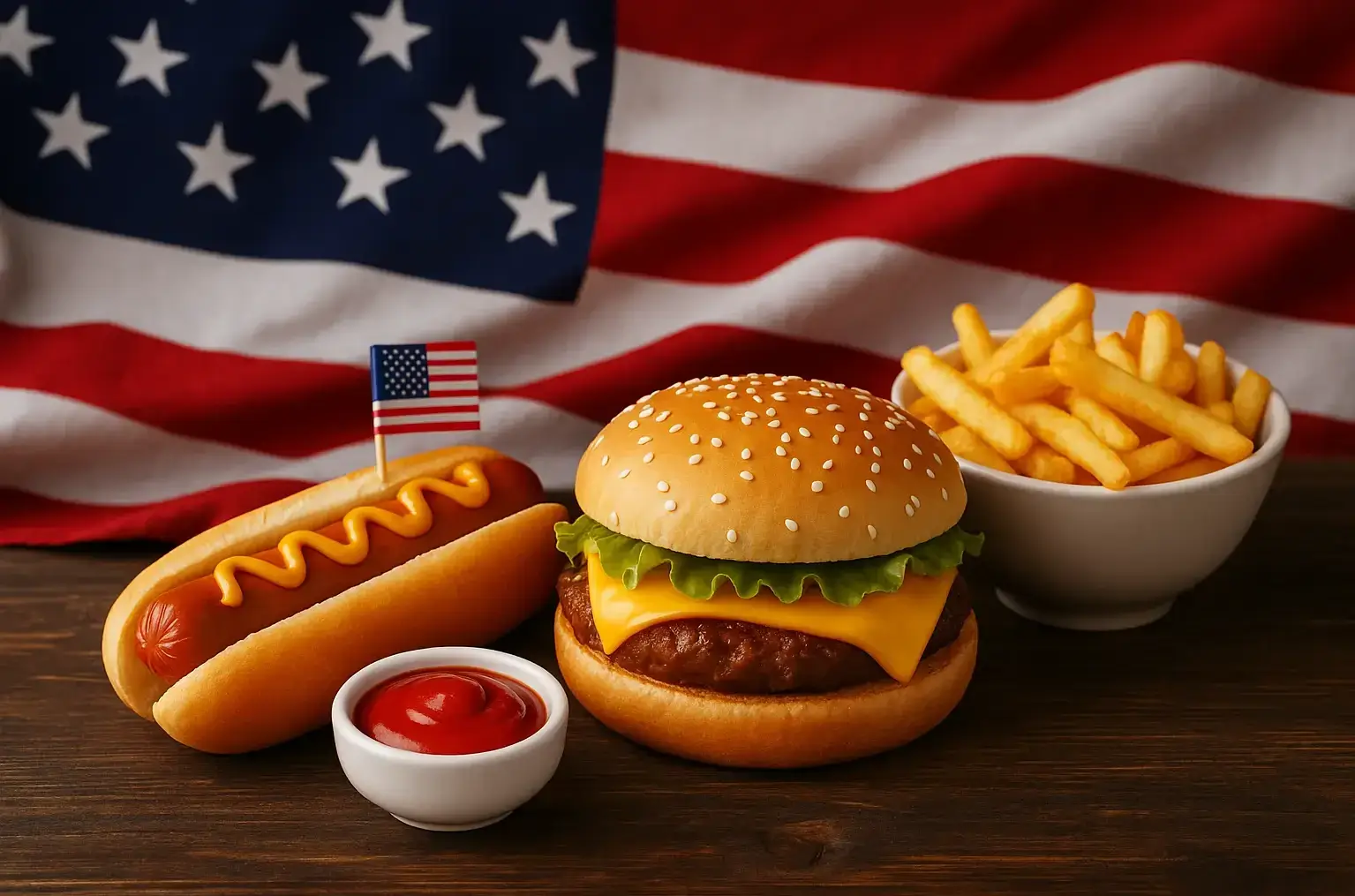4, Sep 2025
What Are Some American Foods

What Are Some American Foods That Will Surprise You Beyond Burgers and Fries
What are some American foods? That question hits different depending on who you ask. For some, it’s pancakes stacked so high you need strategy to tackle them. For others, it’s barbecue that smells like smoke and summer nights. The thing is, food in America isn’t one story—it’s a million small stories that somehow ended up sharing a table. And that table is way bigger than burgers and fries.
Regional diversity in American foods
America is massive, and its food reflects that geography. In the South, soul food shines with fried chicken, collard greens, and cornbread. In New England, clam chowder warms up cold winters, while lobster rolls make summer coastal drives unforgettable. Meanwhile, the Southwest offers spicy Tex-Mex, with burritos, tacos, and chili layered with flavor. Each region holds tight to its own culinary identity, shaped by history, climate, and migration patterns.
Take Cajun and Creole cuisines in Louisiana. Both borrow from French, Spanish, and African traditions, but they differ in spice and preparation. Gumbo, jambalaya, and crawfish boils are more than meals—they’re social rituals. Out West, fresh produce and seafood dominate, giving rise to dishes like fish tacos and avocado toast, long before they trended globally. The beauty of American food is how local traditions become national treasures.
Even within regions, micro-cultures emerge. The Midwest may be known for casseroles, but Chicago pizza and Kansas City barbecue live in separate culinary worlds. You could drive a hundred miles and encounter completely new flavor traditions. That’s the real essence of American cuisine: endless reinvention across a sprawling map.
How American breakfasts became iconic
Breakfast in America is more than a meal—it’s a cultural statement. Pancakes drenched in maple syrup, bacon sizzling in the pan, and eggs cooked every way imaginable are staples. But each region has its own spin. Bagels with lox are a New York City classic, while biscuits and gravy dominate Southern mornings. The variety is unmatched, and breakfast foods often reflect immigrant influences alongside classic staples.
For instance, cereal is one of the most distinct American food inventions. Born out of the 19th-century health movement, it quickly became a household staple. Fast-forward to today, and cereal aisles are lined with colorful boxes that spark nostalgia in anyone who grew up in the U.S. Diner culture also shaped breakfast traditions, serving hearty plates to early risers and late-night wanderers alike.
Interestingly enough, brunch culture has added yet another layer. Combining savory and sweet, brunch often features mimosas, avocado toast, and Eggs Benedict. It’s less about the meal itself and more about the social ritual. You see, American breakfasts tell the story of a nation that values both speed (grab-and-go cereal) and indulgence (all-you-can-eat pancake stacks).
The role of barbecue in American cuisine
Barbecue is not just food—it’s identity. Ask someone from Texas, and they’ll swear by brisket. Head to North Carolina, and it’s all about pulled pork with a vinegar-based sauce. Kansas City is known for its smoky ribs drenched in thick, sweet sauces, while Memphis barbecue emphasizes slow-cooked pork shoulder. Each barbecue style reflects local traditions, resources, and tastes.
At its core, barbecue is communal. Cookouts, tailgates, and backyard gatherings bring people together around the smoker or grill. The smell of wood smoke carries memories of summer holidays, family reunions, and neighborhood block parties. It’s less about the cut of meat and more about the shared experience of eating together.
Then again, barbecue is also competitive. Pitmasters spend years perfecting their rubs and sauces, often keeping recipes secret. National competitions highlight regional pride, showcasing barbecue as a true American art form. Whether messy ribs or carefully smoked brisket, barbecue speaks to a deep tradition of patience, skill, and storytelling through food.
Comfort foods that define American culture
When life feels heavy, comfort food steps in. Macaroni and cheese, meatloaf, mashed potatoes, and fried chicken are dishes people associate with home and warmth. These foods are tied to family gatherings, childhood memories, and holiday tables. They might not be fancy, but they’re reliable in delivering comfort and nostalgia.
Interestingly enough, comfort foods often vary by region. In the Midwest, casseroles (sometimes called hotdish) are iconic. In the South, fried catfish and hush puppies fill the role. Up north, pot roast and stews become staples for cold winters. Each dish reflects local resources but connects emotionally across generations.
Modern spins on comfort foods have also emerged. Gourmet versions of grilled cheese or loaded mac and cheese show up on restaurant menus, proving that these simple staples still resonate. Comfort food remains one of the strongest cultural threads in American food because it’s tied not just to hunger, but to memory and belonging.
Holiday and celebration foods in America
No country celebrates with food quite like America. Thanksgiving is the crown jewel, with turkey, stuffing, cranberry sauce, and pumpkin pie filling tables coast to coast. Beyond Thanksgiving, Christmas often features ham, cookies, and festive drinks like eggnog. Independence Day means cookouts with hot dogs, burgers, corn on the cob, and plenty of pie.
Regional traditions sneak into celebrations, too. In the South, cornbread stuffing may replace bread stuffing, while in Italian-American homes, lasagna might join the Christmas table. Food during holidays often tells the story of cultural roots blending with mainstream traditions.
What’s more, holidays are about abundance. The joy isn’t just in the dishes but in the act of sharing. Potlucks, buffets, and oversized portions are symbols of generosity and togetherness. These celebrations reveal how American food isn’t just about what’s on the plate—it’s about who’s sitting around the table.
Street food and fairground classics in the US
Street food may not be the first thing people think of when it comes to America, but it has a vibrant history. Hot dog carts in New York City are as iconic as the skyline. In Los Angeles, taco trucks serve some of the most authentic Mexican flavors outside Mexico itself. Pretzels, pizza by the slice, and falafel wraps also dot city corners, feeding people on the move.
Fairground food deserves its own spotlight. Corn dogs, funnel cakes, and deep-fried everything define American fairs and carnivals. These foods are playful, indulgent, and tied to childhood nostalgia. The creativity knows no limits—from fried Oreos to giant turkey legs, fairs showcase American ingenuity in the form of fried, portable snacks.
Interestingly enough, these foods often start at local fairs and later spread nationwide. Take kettle corn, for instance—it’s now a common grocery store item but started as a fairground staple. Street and fair foods remind us that American cuisine doesn’t only live in restaurants—it thrives where people gather to celebrate, wander, and play.
The influence of immigrant communities on American food
America is often described as a melting pot, and nowhere is that more visible than in food. Pizza and pasta from Italian immigrants, bagels and deli traditions from Jewish communities, tacos and tamales from Mexican culture—all have become part of mainstream American dining. Immigration shaped the food landscape more than any other force.
Each wave of immigrants brought unique flavors that blended with existing traditions. Chinese immigrants introduced stir-fries and dim sum, leading to uniquely American versions like chop suey and General Tso’s chicken. Vietnamese immigrants popularized pho and banh mi, now staples in many cities. Ethiopian, Indian, and Middle Eastern cuisines continue to expand the American palate.
The fascinating thing is how quickly these foods integrate. What starts as “ethnic food” often becomes simply “food.” For many Americans, pizza and tacos aren’t foreign—they’re weekly meals. This constant blending keeps American cuisine evolving, proving that identity and taste are never fixed.
Famous American snacks and fast food staples
Fast food may be America’s most famous export. Burgers, fries, fried chicken, and milkshakes dominate global perceptions of American cuisine. Chains like McDonald’s, KFC, and Burger King spread these staples worldwide, shaping how other countries view U.S. food culture. But within America, fast food is just one part of the story.
Snacks are just as iconic. Think potato chips, pretzels, peanut butter cups, and popcorn. These everyday items fill lunch boxes, vending machines, and movie theaters. They may not be glamorous, but they’ve achieved legendary status in American culture. After all, who hasn’t grabbed a bag of chips for comfort at some point?
On the other hand, regional fast food chains offer unique spins. In-N-Out Burger on the West Coast, Waffle House in the South, and White Castle in the Midwest each bring local flair. These smaller chains show that even within the fast food scene, diversity thrives.
Sweet treats and desserts unique to the US
No exploration of American food is complete without desserts. Apple pie may be the most symbolic, but brownies, chocolate chip cookies, and cheesecake deserve recognition too. Each dessert has a backstory tied to innovation and adaptation. For example, chocolate chip cookies were invented by accident in the 1930s—and became a global favorite.
Regional desserts also shine. Key lime pie in Florida, pecan pie in the South, and whoopie pies in Maine highlight local ingredients and traditions. Even ice cream has strong roots in America, with brands like Ben & Jerry’s and Baskin-Robbins shaping the culture of scoops and cones.
Interestingly enough, desserts often embody celebration. Birthday cakes, holiday cookies, and after-school brownies remind us that sweetness is tied to joy. The American sweet tooth is strong, and its desserts reflect a playful, inventive spirit that keeps evolving.
Health trends and modern twists on American foods
As much as America celebrates indulgence, it’s also a land of food innovation. Health-conscious trends have transformed classics into lighter versions. Think cauliflower crust pizza, plant-based burgers, and air-fried chicken. These twists allow people to enjoy familiar flavors while aligning with modern lifestyles.
Farm-to-table dining also reflects a growing awareness of sustainability. Fresh, local ingredients now take center stage in many restaurants, often with a focus on seasonal produce. Organic foods, vegan options, and gluten-free alternatives have entered mainstream menus, showing that American cuisine adapts as quickly as tastes change.
At the same time, fusion cooking pushes boundaries. Chefs experiment with blending global cuisines, creating dishes like sushi burritos or Korean barbecue tacos. These innovations show that American food isn’t locked in tradition—it thrives on creativity and experimentation.
Conclusion
So, what are some American foods? The answer is as wide and varied as the country itself. From barbecue pits in the South to lobster shacks in New England, from diner breakfasts to street tacos, the foods of America tell stories of history, culture, and community. They reveal traditions passed down through generations, flavors borrowed and reinvented, and a constant push to create something new.
American cuisine isn’t just about eating—it’s about belonging, celebrating, and sharing. Whether you crave comfort food, holiday feasts, or modern twists, there’s always something on the table that feels familiar yet surprising. That’s the beauty of American food: it never stops evolving, just like the people who make it.
If this post made you hungry—or reminded you of a dish you love—drop a comment, share it with friends, or subscribe for more food stories. After all, food is best enjoyed when shared.
FAQ on American Foods
What are some traditional American foods?
Traditional American foods include apple pie, fried chicken, hamburgers, hot dogs, macaroni and cheese, and clam chowder. These dishes have stood the test of time and are commonly associated with the cultural identity of the U.S.
What foods are unique to the United States?
Some foods unique to the U.S. are buffalo wings, cornbread, tater tots, s’mores, and peanut butter and jelly sandwiches. While inspired by different global cuisines, these dishes were either invented or popularized in America.
What is the most popular American comfort food?
Macaroni and cheese consistently tops the list of American comfort foods. Other favorites include fried chicken, mashed potatoes, and grilled cheese sandwiches. These meals are tied to nostalgia and home-cooked traditions.
What role does barbecue play in American food culture?
Barbecue is central to American food culture, with distinct regional variations such as Texas brisket, Carolina pulled pork, Memphis ribs, and Kansas City burnt ends. Beyond the food itself, barbecue often represents community, competition, and tradition.
How do immigrant communities influence American cuisine?
Immigrant communities have shaped American cuisine profoundly. Italian immigrants popularized pizza and pasta, Mexican communities introduced tacos and tamales, while Chinese, Vietnamese, and Middle Eastern cuisines continue to shape the evolving food scene. America’s culinary diversity is largely thanks to its immigrant heritage.
What desserts are iconic in American culture?
Iconic American desserts include apple pie, brownies, chocolate chip cookies, cheesecake, and key lime pie. Many of these desserts carry regional ties, but all reflect the inventive spirit of American bakers and chefs.
Is fast food really considered American cuisine?
Yes, fast food is a major part of American cuisine, though it’s just one aspect. While chains like McDonald’s and KFC define American food abroad, inside the U.S. regional fast food chains and diverse local restaurants paint a much broader picture.
What are some regional foods in America?
Regional foods include New England clam chowder, Southern fried chicken, Tex-Mex cuisine, Chicago deep-dish pizza, Cajun gumbo, and Pacific Northwest salmon. Each region reflects its local resources and cultural influences.
What are typical American holiday foods?
Thanksgiving turkey, stuffing, cranberry sauce, pumpkin pie, and Christmas ham are typical holiday foods. Celebrations often feature a mix of traditional American dishes and foods tied to family heritage.
How is American food changing today?
American food is shifting toward health-conscious trends such as plant-based meals, organic produce, and fusion cuisines. Farm-to-table dining, gluten-free adaptations, and global flavor influences are shaping the modern American table.
- 0
- By Pankajatray
- September 4, 2025 19:41 PM

